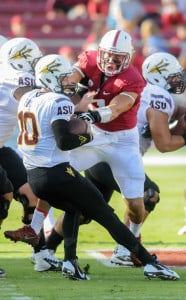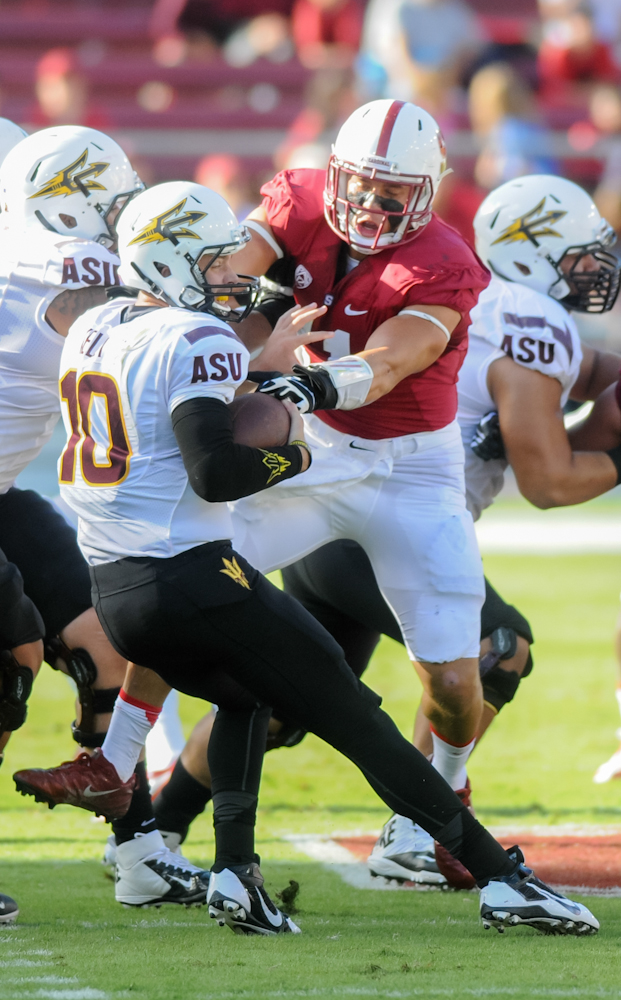The Stanford defense’s “Party in the Backfield” has certainly continued into 2013, as the Cardinal has seven sacks and 22 tackles for loss through three games — two of which were played against quick-strike spread teams. But the Stanford front seven also looks a bit different than it did in 2012, when the team finished first in the country in sacks, second in tackles for loss and fifth in rush defense. The departures of starting outside linebacker Chase Thomas and his backup, Alex Debniak, prompted James Vaughters’ switch to the position. The team also lost defensive end Henry Anderson for several weeks when he was injured against Army. We asked football writers Winston Shi, Do-Hyoung Park and David Cohn: Is Stanford’s early-2013 front seven better than its late-2012 counterpart?
Winston: Stanford’s front seven has been absolutely marvelous this year. How do we know this? Stanford hasn’t yet played a team that was willing to consistently run the ball up the gut. The Stanford front seven has intimidated opponents to the point where they don’t really dare run at it or attempt sustained pass protections. And this was recently shown to be warranted — Stanford controlled a respectable Arizona State offensive line with a three-man rush for the most part.

Stanford’s big guys have not yet been tested, and that is by design. This goes back to last year’s Arizona game, in which the Cardinal front seven nearly decapitated Wildcat quarterback Matt Scott several times in Arizona’s first two drives. Panicking, Arizona coach Rich Rodriguez eschewed pass protection altogether and started throwing quick screens to the outside.
Although Arizona wasn’t very explosive, Scott’s accuracy and reliability allowed Arizona to mount long drives. When UCLA achieved some success in the Pac-12 Championship Game with similar tactics, a lot of people evidently thought that Rodriguez had found the key to beating the Stanford defense.
This year, ASU and SJSU have attempted the same tactic, but neither won their games against the Cardinal defense. As an offensive foundation play, screens aren’t very efficient — they’re meant to be a complement to other plays. Taking a different tack, Army’s triple option actually left key front seven players unblocked — another way to deal with, but not neutralize, a great run defense. But from two disparate approaches we can learn one key fact: If Stanford’s front seven is forcing opponents to design entire game plans around avoiding it, that already makes it one of the finest units in college football.
Do: Winston certainly makes a good point by saying that the sheer fact that opponents are refraining from challenging the Stanford front seven is a testament to the respect that those programs have for the Cardinal’s defensive rotation. But I disagree with his argument that such a trend makes it implicit that this year’s front seven is one of the finest in college football.
I think that instead, it’s actually a nod to last season’s tremendous front seven, not the current one, that Stanford’s early-2013 opponents have supposedly crafted their game plans to avoid running up the middle or having to maintain consistent pass protection.
Last year’s front seven had an elite combination of strength and speed while working incredibly efficiently as a unit. Shayne Skov, Ben Gardner and Trent Murphy would consistently explode into the backfield, and A.J. Tarpley was always reliable in pass coverage. That was the front seven that completely shut down the vaunted juggernaut known as the Oregon Ducks’ offense. That front seven emerged victorious from many an epic battle up front.
But this year’s front seven, while returning most of the same characters, just hasn’t been tested as a unit in the same way that last year’s unit was. Entire units on teams can change drastically from year to year (see: Oregon State defense), and there’s really not any way to tell how good this year’s seven are until they face the likes of Washington or UCLA.
Because of that, I’m going to side with the unit that established itself and cemented itself as one of the most feared crews in the nation last year. Stanford’s front seven of 2012 defined the word “elite,” and, as for this year, I won’t believe it until I see it.
David: While I do not believe Stanford’s front seven in 2013 is as talented as the group from the end of last season, the drop-off is not as significant as it may seem to many. On one hand, defensive stalwart Chase Thomas — now a member of the Atlanta Falcons practice squad — has certainly been missed, as his 7.5 sacks constituted the second highest total in 2012 for the Cardinal behind Trent Murphy’s 10.
In total, the departures of Thomas, Alex Debniak and Terrence Stephens — who combined for nearly 22 percent of the Card’s 57 sacks from last season — has resulted in a decrease in the front seven’s percentage of sacks per opponent pass attempts from 8.6 percent in 2012 to 6.0 percent in 2013.
However, when one considers the front seven’s production in terms of both quarterback hurries and sacks, its percentage of sacks and quarterback hurries per opposing pass attempt has actually slightly increased, from 12.4 percent last year to 12.8 percent this season.
These statistics seem to indicate that Stanford’s defensive line and linebackers have had a comparable amount of success in applying pressure on the quarterback. At the same time, the numbers also show that the front seven can improve on translating such pressure into sacks and tackles for loss by minimizing missed tackles.
David and his statistical analysis are standing by while Do and Winston settle their disagreements with a ferocious thumb war. If you want David to do your taxes while he waits, send him an email at dmcohn ‘at’ stanford.edu. Send Do and Winston support as they do battle at dpark027 ‘at’ stanford.edu and wshi94 ‘at’ stanford.edu.
